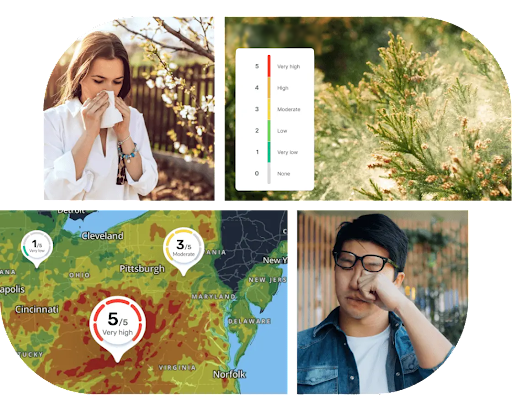
Interfejs Pollen API umożliwia wysyłanie żądań danych o pyłkach dla określonej lokalizacji. Dane o pyłkach obejmują regionalne gatunki roślin i rodzaje pyłków, a także indeks pyłków i zalecenia dotyczące zdrowia.1 Interfejs Pollen API obejmuje ponad 65 krajów i ma rozdzielczość 1 x 1 km.
Interfejs API udostępnia punkty końcowe, które umożliwiają wysyłanie zapytań o:
Prognoza: prognoza stężenia pyłków na maksymalnie 5 dni z informacjami dziennymi, w tym indeksem pyłków dla różnych rodzajów roślin.2
Mapy termiczne: kafelki z 3 rodzajami pyłków oznaczone kolorami.
Funkcje interfejsu Pollen API
Codzienna prognoza indeksu pylenia i kategorii: interfejs Pollen API stale oblicza wartość różnych rodzajów pyłków i indeksów roślin w rozdzielczości 1 x 1 km.
Rekomendacje dotyczące zdrowia: rekomendowane informacje o zdrowiu na podstawie aktualnego poziomu pyłków. Zalecenia dotyczące zdrowia są wdrażane na poziomie typu rośliny zgodnie z poziomem indeksu pyłków.[^1]
Szczegóły opisu rośliny: szczegółowe informacje o różnych gatunkach, które są powiązane z rośliną i jej potencjalnym działaniem alergizującym. Opis zawiera następujące informacje: typ, rodzina, sezon, specjalne kształty, specjalne kolory, reakcja krzyżowa i 2 zdjęcia każdej rośliny.
Mapy cieplne: zbiór kafelków obrazów indeksu typu pyłku, które można wyświetlać na mapach Google.
Kraje i regiony objęte interfejsem Pollen API
Najnowsze informacje o zasięgu, w tym o tym, w których krajach dostępne są informacje o pyłkach i roślinach, znajdziesz na stronie Obsługiwane kraje i rośliny w interfejsie Pollen API.
Jak korzystać z interfejsu Pollen API
| 1 | Konfiguracja | Zacznij od sekcji Konfigurowanie projektu Google Cloud i postępuj zgodnie z instrukcjami. |
| 2 | Otrzymywanie codziennych informacji o prognozie pylenia | Zobacz Uzyskiwanie prognozy. |
| 3 | Pobieranie kafelków mapy termicznej | Zobacz Pobieranie fragmentów mapy termicznej. |
Co dalej?
-
Liczba dni prognozy może się różnić w zależności od lokalizacji i gatunku rośliny. ↩

